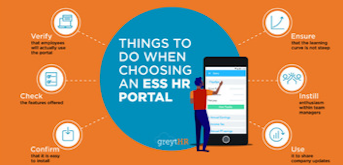Reason to automate your Employee Management System
Every automation has its share of advantages and disadvantages. As we know it, business automation helps in a faster and smarter way to perform transactions, deliver goods or services, communicate and resolve issues. It eliminates a whole lot of manual work and efforts by bringing in speed, efficiency & consistency. The disadvantages are that it requires budget, installation, training & regular maintenance or upgrades. Ultimately, businesses have come around to realize that automating the processes has better prospects rather than being left behind.
But then, is it safe to say it is advantageous in all areas of business or functions? How does this fare for employee-centric functions like HR or Payroll? Does automation create a gap or an artificial boundary between HR and employees? Would employees miss the human face of HR? This wafer-thin line needs to be managed delicately so that employees do not feel alienated.
While there is no question of avoiding automation in HR processes, it must be introduced in functions or methods that will eliminate manual, time-consuming, and mundane tasks for employees and HR.
Let us consider the advantages of an employee self-service (ESS) portal in an HR system. It would significantly assist employees in submitting their information or documents from the comforts of their office or remote location and, on the other hand, for HR / Payroll to take necessary actions.
Advantages of Employee Self-Service Portal
Personal / Bank / Social security details or updates
Certain personal information such as an address for communication, email id, phone numbers, emergency contacts, social security numbers or bank details, medical history, etc., are required to be submitted by employees using the ESS portal and is securely stored by HR for future communication or for processing payments or salaries.
Time, Leave & attendance
Organizations are continually looking for better innovative methods to accurately capture the time, attendance, and leave records of their employees, no matter wherever they are working from. Employees find it convenient to submit their information through ESS if they do it from a remote location or through any bio-metric machine installed at their workplace. This data is collated regularly for further use by the HR / Payroll.
Expense claims
Expense claims or reimbursement submissions can be made electronically, including copies of supporting documents. Expense heads with allowable limits and authorization matrix can be configured in the system as per HR policies, further eliminating the need to validate them by Payroll or Finance teams.
Medical claims and data updation
Organizations that cover employees and their respective families in a company medical scheme can collate the relevant personal data through the system for appropriate medical coverage and premium payments. Most insurance service providers require an annual update of employee data for inclusions or otherwise.
Queries, Issues, concerns & suggestions
Employees generally provide or suggest good ideas for improving an implementable process. A portal or a chatbot will help them submit it online while they feel somebody is listening to them and taking in their suggestions. General queries on company policies or HR-related queries can be responded through the chatbot or a FAQ chart.
Overtime tracker and approvals
Overtime is an additional expense to an organization. It is treated like any other expense claim submissions through their respective managers, who need to approve the number of OT hours performed for payment through payroll. Systems can also be configured to obtain prior approval and then submit the actual OT hours once actually completed.
Modern HR and Payroll systems support employee management systems or ESS portals through a number of years of experience in this field.
An HR & Payroll software, like greytHR, can provide the right solution to SMBs. Present across 22+ countries, including Bahrain, Kuwait, Oman, Qatar, Saudi Arabia and the United Arab Emirates, greytHR not only helps process accurate payroll every month but also comes with in-built statutory compliance, expense management, and leave and attendance management modules.








